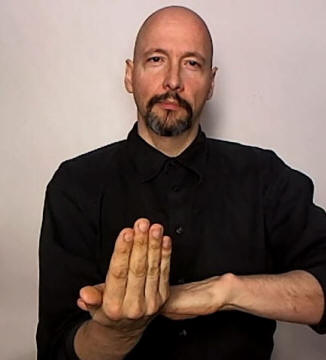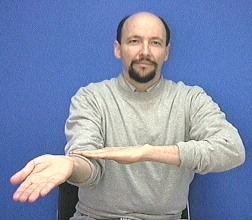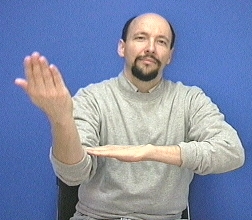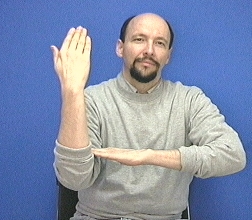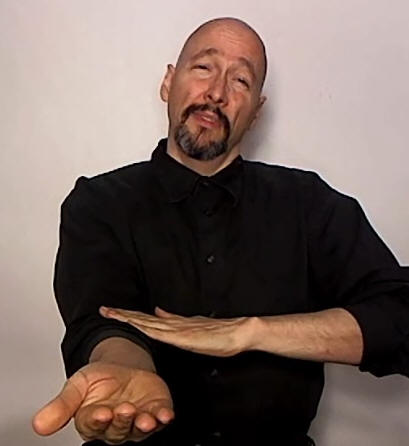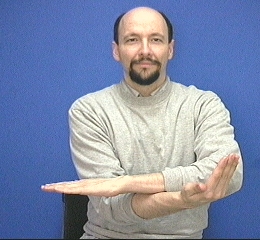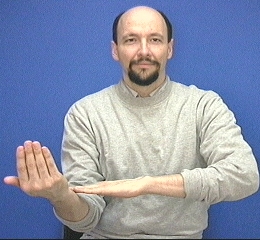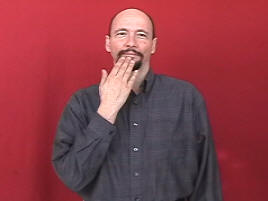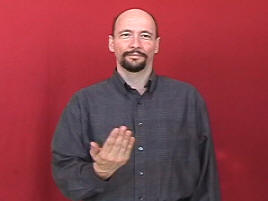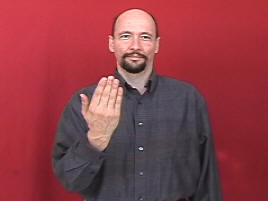American Sign Language: "morning"
The sign for "morning" uses a palm-up flat hand (or slightly bent hand) on the dominant hand to represent the sun rising up from beneath the horizon. The non-dominant arm plays the role of the horizon. The wrist of the dominant hand contacts the the non-dominant hand's fingers. Sometimes you'll see a little repeated movement of the dominant hand, but often (such as in the case of saying "good morning") you only use a single movement.
MORNING:
Sample sentence: "What did you eat this morning?" = NOW MORNING EAT WHAT?
You can modify the sign "morning" to mean "all morning" by using a larger movement.
ALL-MORNING:
Normally the contact for the sign MORNING is done at the wrist, but notice how for the sign "ALL-MORNING" the dominant hand is hyper extended at the beginning of the sign and the non-dominant hand is actually touching near the elbow. This allows for a lot of "movement" to help convey the idea that a lot of time is passing.
You can vary use an unpleasant facial expression to help show "very early" in the morning. Do a short, quick movement and don't bring the dominant hand up much past the "horizon." This conveys the concept of the sun not having come up yet.
You can modify the sign for "morning" to mean "every morning" by using a horizontal sweep movement:EVERY-MORNING
Sample sentence: Every morning do you rush to shower, get dressed, eat, and take off for school?
Notes:
The left palm should not grab onto the bicep. Instead, the left palm should usually be near the right wrist. The movement shouldn't be very large either. (Unless you are doing the "ALL MORNING" version). The sign for "morning" is generally a just small movement.
MORNING (version) (NOT recommended).
(Unless you are just naturally a duffus. If so, by all means feel free. In that case this version works scintillatingly well when wishing rival gang members a jolly "good morning.")
My wife just came by as I was typing the above and she said she sees nothing wrong with having the non-dominant hand near the elbow when doing a "very enthusiastic" GOOD MORNING! (Note the exclamation point.) Okay, okay, fine. I'll grant that if you around one of those annoyingly cheerful "morning people" (you know the type) you just might see the non-dominant hand near the bicep.
Oh, and for what it is worth, I don't recommend calling your wife a duffus. Ahem.
Even though the sign "morning" normally uses two hands, quite often we will just use one hand in expressing such a common everyday phrase as "Good morning." The one-handed version is rather useful for when you are holding a cup of hot chocolate while signing GOOD-MORNING.
GOOD-MORNING:
Want to help support
ASL University? It's easy:
DONATE (Thanks!)
(You don't need a PayPal account. Just look for the credit card
logos and click continue.)
Another way to help is to buy something from the ASLU "Bookstore."
Want even more ASL resources? Visit the "ASL Training Center!" (Subscription
Extension of ASLU)
CHECK IT OUT >
Bandwidth slow? Check out "ASLUniversity.com" (a
free mirror of
Lifeprint.com less traffic, fast access)
VISIT >
You can learn
sign language
(ASL) online at American Sign Language University ™
Lifeprint.com © Dr. William Vicars
